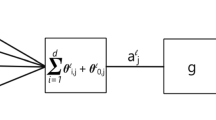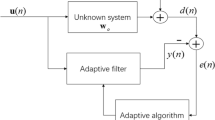Abstract
Recently, a Bayesian receiver for blind detection in fading channels has been proposed by Chen, Wang and Liu (200,IEEE Trans. Inform. Theory,46, 2079–2094), based on the sequential Monte Carlo methodology. That work is built on a parametric modelling of the fading process in the form of a state-space model, and assumes the knowledge of the second-order statistics of the fading channel. In this paper, we develop a nonparametric approach to the problem of blind detection in fading channels, without assuming any knowledge of the channel statistics. The basic idea is to decompose the fading process using a wavelet basis, and to use the sequential Monte Carlo technique to track both the wavelet coefficients and the transmitted symbols. Moreover, the algorithm is adaptive to time varying speed/smoothness in the fading process and the uncertainty on the number of wavelet coefficients (shrinkage order) needed. Simulation results are provided to demonstrate the excellent performance of the proposed blind adaptive receivers.
Similar content being viewed by others
References
Andrieu, C., de Freitas, J. F. G. and Doucet, A. (1999). Sequential MCMC for Bayesian model selection,Proceedings of IEEE Higher Order Statistics Workshop, Israel. (Available http://citeseer.nj.nec. com/andrieu99sequential.html)
Andrieu, C., de Freitas, J. F. G. and Doucet, A. (2000). Sequential Bayesian estimation and model selection for dynamic kernel machines, Tech. Report, TR 341, Cambridge University. (Available http://citeseer.nj.nec.com/andrieu00sequential.html)
Chen, R. and Liu, J. S. (2000). Mixture Kalman filters,J. Roy. Statist. Soc. Ser. B,62, 493–509.
Chen, R., Wang, X. and Liu, J. S. (2000). Adaptive joint detection and decoding in flat-fading channels via mixture Kalman filtering,IEEE Trans. Inform. Theory,46, 2079–2094.
Chipman, H., Kolaczyk, E. and McCulloch, R. (1997). Adaptive Bayesian wavelet shrinkage,J. Amer. Statist. Assoc.,92, 1413–1421.
Clyde, M. and George, E. (2000). Flexible empirical Bayes estimation for wavelets,J. Roy. Statist. Soc. Ser. B,62, 681–698.
Collings, I. B. and Moore, J. B. (1994). An HMM approach to adaptive demodulation of QAM signals in fading channels,International Journal of Adaptive Control and Signal Processing,8, 457–474.
Daubechies, I. (1988). Orthonormal bases of compactly supported wavelets,Comm. Pure Appl. Math.,41, 425–455.
Daubechies, I. (1992).Ten Lectures on Wavelets, Society for Industrial and Applied Mathematics, Philadelphia.
Donoho, D. and Johnstone, I. (1994). Multiple shrinkage and subset selection in wavelets,Biometrica,81, 425–455.
Doucet, A., Godsill, S. and Andrieu, C. (2000). On sequential Monte Carlo sampling methods for Bayesian filtering,Statist. Comput.,10, 197–208.
Doucet, A., de Freitas, J. F. G. and Gordon, N. (2001).Sequential Monte Carlo in Practice, Cambridge University Press, Cambridge.
Georghiades, C. N. and Han, J. C. (1997). Sequence estimation in the presence of random parameters via the EM algorithm,IEEE Trans. Commun.,COM-45, 300–308.
George, E. and McCulloch, R. (1993). Variable selection via Gibbs sampling,J. Amer. Statist. Assoc.,88, 881–889.
Guo, D., Wang, X. and Chen, R. (2002). Wavelet-based sequential Monte Carlo blind receivers in fading channels with unknown channel statistics,IEEE International Conference in Communications (ICC 2002), New York.
Haeb, R. and Meyr, H. (1989). A systematic approach to carrier recovery and detection of digitally phase modulated signals on fading channels,IEEE Trans. Commun.,37, 748–754.
Hoeting, A. J., Madigan, D., Raftery, A. E. and Volinsky, C. T. (1999). Bayesian model averaging: A tutorial,Statist. Sci.,14, 382–417.
Liu, J. S. (2001).Monte Carlo Strategies in Scientific Computing, Springer, New York.
Liu, J. S. and Chen, R. (1995). Blind deconvolution via sequential imputations,J. Amer. Statist. Assoc.,90, 567–576.
Liu, J. S. and Chen, R. (1998). Sequential Monte Carlo methods for dynamic systems,J. Amer. Statist. Assoc.,93, 1032–1044.
Liu, J. and West, M. (2001). Combined parameter and state stimation in simulation-based filtering,Sequential Monte Carlo Methods in Practice (eds. A. Doucet, N. de Freitas and N. Gordon), 197–217, Springer, New York.
Lodge, J. H. and Moher, M. L. (1990). Maximum likelihood sequence estimation of CPM signals transmitted over Rayleigh flat-fading channels,IEEE Trans. Commun.,38, 787–794.
Madigan, D. and Raftery, A. E. (1994). Model selection and accounting for model uncertainty in graphical models using Occam’s window,J. Amer. Statist. Assoc.,89, 1535–1546.
Madigan, D. and York, J. (1995). Bayesian graphical models for discrete data,Internat. Statist. Rev.,63, 215–232.
Martone, M. (2000). Wavelet-based separating kernels for array processing of cellular DS/CDMA signals in fast fading,IEEE Trans. Commun.,48, 979–995.
Proakis, J. G. (1995).Digital Communications, 3rd ed., McGraw-Hill, New York.
Raftery, A. E., Madigan, D. and Hoeting, J. (1997). Bayesian model averaging for linear regression models,J. Amer. Statist. Assoc.,92, 179–191.
Volinsky, C. T., Madigan, D., Raftery, A. E. and Kronmal, R. A. (1997). Bayesian model averaging in proportional hazard models: Assessing the risk of a stroke,J. Roy. Statist. Soc. Ser. C,46, 433–448.
Author information
Authors and Affiliations
Additional information
This work was supported in part by the U.S. National Science Foundation (NSF) under grants CCR-9875314, CCR-9980599, DMS-9982846, DMS-0073651 and DMS-0073601.
About this article
Cite this article
Guo, D., Wang, X. & Chen, R. Nonparametric adaptive detection in fading channels based on sequential Monte Carlo and Bayesian model averaging. Ann Inst Stat Math 55, 423–436 (2003). https://doi.org/10.1007/BF02530509
Received:
Revised:
Issue Date:
DOI: https://doi.org/10.1007/BF02530509




